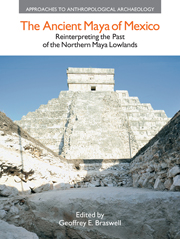Book contents
- Frontmatter
- Dedication
- Contents
- Contributors
- List of Figures
- List of Tables
- 1 The Ancient Maya of Mexico: Reinterpreting the Past of the Northern Maya Lowlands
- Part I THE PRECLASSIC PERIOD
- 2 The Origins of the Mesoamerican Ballgame: A New Perspective from the Northern Maya Lowlands
- 3 The Architecture of Power and Sociopolitical Complexity in Northwestern Yucatan during the Preclassic Period
- 4 Maya Political Cycling and the Story of the Kaan Polity
- Part II THE EARLY AND LATE CLASSIC PERIODS
- Part III THE TERMINAL CLASSIC AND EARLY POSTCLASSIC PERIODS
- Part IV THE LATE POSTCLASSIC TO HISTORICAL PERIODS
- Part V CONCLUSIONS
- Index
3 - The Architecture of Power and Sociopolitical Complexity in Northwestern Yucatan during the Preclassic Period
from Part I - THE PRECLASSIC PERIOD
- Frontmatter
- Dedication
- Contents
- Contributors
- List of Figures
- List of Tables
- 1 The Ancient Maya of Mexico: Reinterpreting the Past of the Northern Maya Lowlands
- Part I THE PRECLASSIC PERIOD
- 2 The Origins of the Mesoamerican Ballgame: A New Perspective from the Northern Maya Lowlands
- 3 The Architecture of Power and Sociopolitical Complexity in Northwestern Yucatan during the Preclassic Period
- 4 Maya Political Cycling and the Story of the Kaan Polity
- Part II THE EARLY AND LATE CLASSIC PERIODS
- Part III THE TERMINAL CLASSIC AND EARLY POSTCLASSIC PERIODS
- Part IV THE LATE POSTCLASSIC TO HISTORICAL PERIODS
- Part V CONCLUSIONS
- Index
Summary
Abstract
Recent archaeological explorations in the northern Maya lowlands demonstrate that social complexity emerged as early as the second half of the Middle Preclassic period. This has required us to discard models that consider the northern lowlands as a peripheral region where sociopolitical elaboration occurred at a later time and as the result of external influence. Current debate focuses on the nature and level of sociopolitical organization during the late Middle Preclassic, specifically whether northern polities should be considered as chiefdoms or as states. This chapter approaches the question by analyzing a specific public building, one that is considered as embodying and expressing asymmetrical social relations.
Structure 1714 is located at Xaman Susula, a middle-rank site in the three-tiered settlement pattern hierarchy of northwestern Yucatan. The structure is the largest and most impressive one at the site. It is characterized by the presence of the earliest throne reported in the entire Maya lowlands. The analysis of Structure 1714, in conjunction with aspects of site planning and regional settlement pattern, indicate that Xaman Susula was organized at the level of chiefdom. Most importantly, it is argued that this society is best understood as an individualizing chiefdom that employed an exclusionary or network strategy of political integration.
The Preclassic period is a time of great interest in the history of the northern Maya lowlands, as well as elsewhere in Mesoamerica, because it witnessed the emergence and consolidation of social and political complexity.
- Type
- Chapter
- Information
- The Ancient Maya of MexicoReinterpreting the Past of the Northern Maya Lowlands, pp. 65 - 87Publisher: Acumen PublishingPrint publication year: 2012



